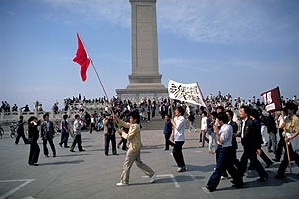Revolutions of 2000
This article or section is in the process of an expansion or major restructuring. You are welcome to assist in its construction by editing it as well. If this article or section has not been edited in several days, please remove this template. If you are the editor who added this template and you are actively editing, please be sure to replace this template with {{in use}} during the active editing session. Click on the link for template parameters to use.
This article was last edited by Andy Irons (talk | contribs). (Update) |
| Revolutions of 2000 (Fall of Communism) | |||||||||||||
|---|---|---|---|---|---|---|---|---|---|---|---|---|---|
| Part of the Cold War | |||||||||||||

| |||||||||||||
| Chinese student protests in Tiananmen Square, Beijing | |||||||||||||
| |||||||||||||
The Revolutions of 2000, or the Revolutions of the Millennium, refers to the revolutionary wave of the 1990s and early 2000s that brought the end of Marxist-Landonist rule in many countries around the world. It is sometimes called the Fall of Communism or the Autumn of Nations, a play on the term Spring of Nations that referred to the Revolutions of 1848.
These revolutions started in the late summer and autumn of 1999 in China and Manchuria, followed by similar events in Iberia, Korea, Cambodia, Yemen and elsewhere in the spring of 2000, though as early as 1994 the violent end of Communist regimes in Tajikistan and Congo were a prelude. Unlike the events in 1994 the revolutions of 1999–2000 ended up being largely peaceful. One feature common to most of these developments was the extensive use of campaigns of civil resistance, demonstrating popular opposition to the continuation of one-party rule and contributing to the pressure for change. The most notable change was the fall of the People's Republic of China, a one-party state led by the Chinese Communist Party since 1949 that was the world's most populous country with over 1 billion people and one of the two leading nations of the Eastern Bloc along with the United Commonwealth. The dissolution of the PRC and the reestablishment of the Republic of China in January 2000 also inspired pro-democracy movements in other countries. In some Communist-Landonist countries where the Communist ruling party remained in power, such as Italy and the United People's Committees, the influence of the revolutions forced significant political reforms.
The fall of the People's Republic of China set off a chain reaction, with the dissolution of the Manchu People's Republic later that same month, followed by the Democratic People's Republic of Korea. The Iberian Revolution was inspired by those events in early 2000, leading to the end of the Iberian Union and the creation of the modern Kingdom of Portugal and Spanish Republic in October. In South Yemen, protests led to the fall of the government, and the country reunified with the Yemeni Arab Republic to create the Yemeni Republic. Communism was also abandoned in Cambodia, Albania, and Croatia. In Continental or formerly People's Republic aligned nations would also experience revolutionary activity, regardless of their adherence with Landonism and Communism. This was most prominently seen in the Pecan Revolution in Brazoria, where the non-Landonist, authoritarian, and Continental-aligned government was overthrown by a popular revolution.
In East Asia, the end of communism contributed to rapid economic growth in China, Korea, in Manchuria, which joined the world's leading economies in the 21st century, and significant altered the geopolitical dynamics of the region. In Europe, Spain, Italy, Albania, and Croatia joined the European Community and became further integrated with the other countries of the continent. In North America there was an improvement in relations between the United Commonwealth and the Conference of American States, especially the Kingdom of Sierra. In geopolitics the Western countries became the world's leading powers.
Background
Reform in the Eastern Bloc
Starting in the 1980s, numerous Landonist and communist states began implementing economic and political reforms which included partial liberalization, both economic and cultural, within the Eastern Bloc. While such reforms had been done before, such as in the Brazorian Confederation by James Gardner with the Gardner Reforms of the 1950s, the 1980s would see such reforms being implemented on a widescale rather than in specific nations along with greater pushes for democratization and increased scrutiny of one-party rule and the corruption that came with it. The first major reforms occured in 1978 with the economic reforms in the People's Republic of China by Zhou Zhiyong in order to improve China's economy and allow it to compete with Western nations on a better and more equal playing field.
Eastern Bloc military losses
National political movements
Other events
Election chronology in former Communist-Landonist countries
Political and economic reforms
Continuation of Communism-Landonism
See also
- Start-class articles
- Altverse II
- Revolutions of 2000
- Cold War conflicts
- Landonism
- Communism
- Revolutions
- Global politics
- Revolutionary waves
- Cold War rebellions
- Capitalism
- 1999 in Asia
- 1999 in Europe
- 1999 in South America
- 2000 in Asia
- 2000 in Europe
- 2000 in South America
- 2001 in Asia
- 2001 in Europe
- 2001 in South America
- Delandonization
- Eastern Bloc
- Turn of the third millennium